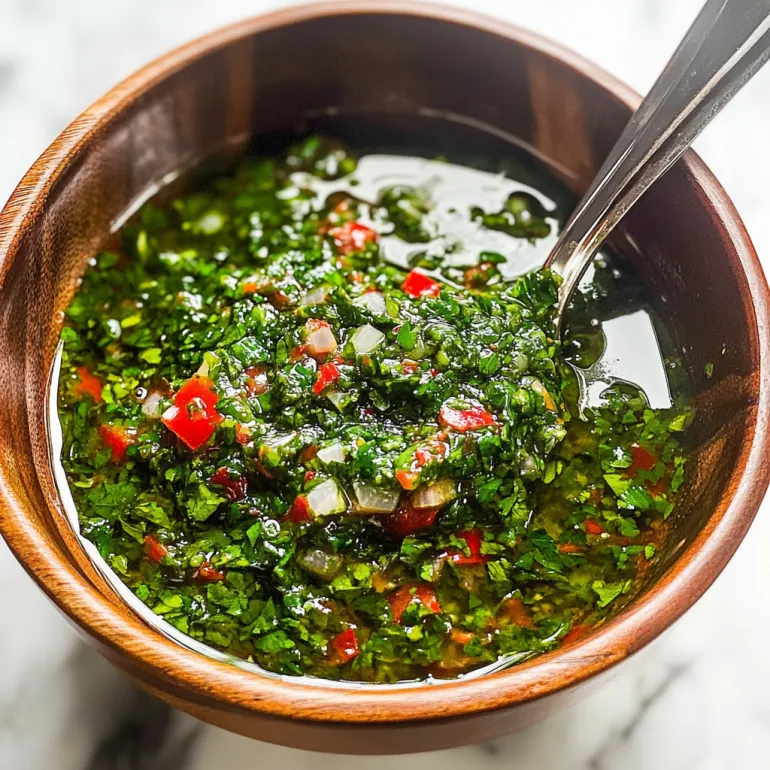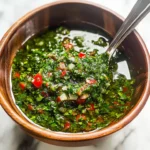What the heck is this?
If you have ever stepped into a Brazilian steakhouse like Texas de Brazil, you know that while the endless skewers of grilled meat are the main event, the chimichurri sauce quietly steals the show. It is that vibrant, herbaceous, punchy green sauce that they ladle generously over steaks, chicken, shrimp, and honestly anything else they can find. Chimichurri is not just a sauce; it is an experience. It is the bright, fresh contrast that cuts through rich meats, making every bite even more mouthwatering. The best part is that this authentic chimichurri recipe captures that restaurant magic but is incredibly easy to whip up at home. It is raw, it is real, and it is ridiculously good.
Why You’ll Love This Recipe
First, it’s outrageously fast to make. No cooking involved — just some chopping and stirring, which means you can pull this off even when you’re tired and hungry. Second, the flavor is off-the-charts fresh. The combination of parsley, garlic, vinegar, olive oil, and a hint of heat hits all the right notes: herbal, garlicky, tangy, and slightly spicy. Third, this chimichurri is versatile. Yes, it’s amazing on steak (obviously), but it also brings grilled chicken, pork, roasted vegetables, shrimp, and even rice or quinoa dishes to life. Fourth, it’s meal-prep friendly. It holds up beautifully in the fridge for days and even improves as the flavors meld. Lastly, making it at home is way cheaper and fresher than buying a jar at the store, which usually tastes dull in comparison.
The Good Stuff You’ll Need
To make a truly memorable chimichurri, you need just a few simple, high-quality ingredients:
1 cup fresh flat-leaf parsley, finely chopped. Avoid curly parsley if you can; it’s too tough and lacks the right flavor.
1/2 cup fresh cilantro, finely chopped. This is optional, but it adds an extra layer of freshness that’s very typical of Texas de Brazil’s style.
4 cloves garlic, finely minced. Don’t skimp here — garlic is one of the stars.
2 tablespoons red wine vinegar. This gives the sauce its signature tang.
1 tablespoon fresh lemon juice. For an added pop of brightness.
1/2 cup extra virgin olive oil. Use a good-quality oil for the best flavor.
1 teaspoon dried oregano. A little earthiness that ties everything together.
1/2 teaspoon crushed red pepper flakes. Adjust more or less depending on how much heat you like.
Kosher salt and freshly ground black pepper, to taste.

Let’s Do This
Step 1: Chop Like You Mean It
Start by finely chopping the parsley and cilantro. You want them small but not pulverized — the sauce should have a rustic texture, not a purée. Mince the garlic very finely as well. Chimichurri is all about balance, so you want bits of herbs and garlic that coat your food, not clumps.
Step 2: Mix It Up
In a medium bowl, combine the chopped parsley, cilantro, garlic, oregano, and crushed red pepper flakes. Stir them together gently. Add the red wine vinegar and lemon juice. Stir again to start marrying the flavors. Slowly pour in the olive oil while stirring to emulsify the sauce slightly. You’re looking for a loose consistency where the herbs are suspended in oil but not drowning in it. Season generously with salt and pepper. Taste it — it should be bright, tangy, garlicky, a little spicy, and well balanced. Adjust as needed.
Step 3: Let It Hang Out
Chimichurri tastes best when it has time to sit and let all the ingredients get to know each other. Let it rest at room temperature for at least 15 to 30 minutes before serving. If you can, make it a few hours ahead and refrigerate it, then bring it back to room temperature before using. The flavors deepen and mellow beautifully over time.
Serving Suggestions
There are few limits to what you can do with a good chimichurri. It is the ultimate steak sauce, no question, but it also does wonders for grilled chicken, pork chops, roasted vegetables, grilled fish, and even lamb. It’s amazing tossed with roasted potatoes or drizzled over a fresh tomato salad. Stir a spoonful into a pot of cooked rice or quinoa to instantly wake up the flavors. You can even use it as a marinade for meats before grilling, just know that the acid will tenderize things quickly, so don’t marinate too long.
Switch It Up
If you want a different flavor profile, you can tweak the chimichurri easily. Hate cilantro? Skip it and double up on parsley. Want more heat? Add a diced fresh chili pepper like jalapeño or Fresno along with the red pepper flakes. Prefer a more acidic bite? Add an extra splash of vinegar or lemon juice. Some variations even include a bit of finely diced shallot for a sweeter, mellow oniony flavor.
Make-Ahead Tips
One of the best things about chimichurri is that it actually improves after a little time in the fridge. Make it a few hours or even a day before you need it, and it will be even better. It keeps well in an airtight container in the refrigerator for up to 5 days. The olive oil may solidify slightly when chilled, but no worries — just let it sit out for 15 to 20 minutes before using and give it a quick stir. If you want to keep it even longer, you can freeze chimichurri in small portions using an ice cube tray. Pop out a cube or two when you need an instant flavor boost.

Questions People Actually Ask
Q: Can I use a food processor instead of chopping by hand?
A: Yes, but pulse carefully. You want a slightly chunky texture, not a purée. Overprocessing turns chimichurri into an herby baby food situation, which is not what we’re aiming for.
Q: What’s the difference between chimichurri and pesto?
A: Chimichurri is herb-based like pesto but lighter and tangier, with no cheese, nuts, or heavy oils. It’s punchier, fresher, and way less rich, making it perfect for cutting through grilled meats.
Q: Do I really have to use fresh herbs?
A: Absolutely. Fresh parsley (and cilantro if using) is non-negotiable. Dried herbs simply won’t give you the same bright, fresh flavor that defines good chimichurri.
Q: Can I freeze chimichurri?
A: You can, though it’s best fresh. If you freeze it, do it in small portions and defrost as needed. Just know the texture may change slightly.
Q: Is this the authentic Argentine chimichurri?
A: This version is inspired by the Texas de Brazil chimichurri, which is a bit more herbaceous and citrusy than the strictly traditional Argentine style. If you want it even closer to traditional, you could skip the cilantro and lemon and stick strictly to parsley, garlic, oregano, vinegar, olive oil, and red pepper.

Best Chimichurri Recipe Ever (Straight from Texas de Brazil)
- Total Time: 10 minutes
- Yield: About 1 1/2 cups 1x
Description
If you have ever stepped into a Brazilian steakhouse like Texas de Brazil, you know that while the endless skewers of grilled meat are the main event, the chimichurri sauce quietly steals the show. It is that vibrant, herbaceous, punchy green sauce that they ladle generously over steaks, chicken, shrimp, and honestly anything else they can find. Chimichurri is not just a sauce; it is an experience. It is the bright, fresh contrast that cuts through rich meats, making every bite even more mouthwatering. The best part is that this authentic chimichurri recipe captures that restaurant magic but is incredibly easy to whip up at home. It is raw, it is real, and it is ridiculously good.
Ingredients
To make a truly memorable chimichurri, you need just a few simple, high-quality ingredients:
1 cup fresh flat-leaf parsley, finely chopped. Avoid curly parsley if you can; it is too tough and lacks the right flavor.
1/2 cup fresh cilantro, finely chopped. This is optional, but it adds an extra layer of freshness that is very typical of Texas de Brazil’s style.
4 cloves garlic, finely minced. Do not skimp here — garlic is one of the stars.
2 tablespoons red wine vinegar. This gives the sauce its signature tang.
1 tablespoon fresh lemon juice. For an added pop of brightness.
1/2 cup extra virgin olive oil. Use a good-quality oil for the best flavor.
1 teaspoon dried oregano. A little earthiness that ties everything together.
1/2 teaspoon crushed red pepper flakes. Adjust more or less depending on how much heat you like.
Kosher salt and freshly ground black pepper, to taste.
Instructions
Start by finely chopping the parsley and cilantro. You want them small but not pulverized — the sauce should have a rustic texture, not a purée. Mince the garlic very finely as well. Chimichurri is all about balance, so you want bits of herbs and garlic that coat your food, not clumps.
In a medium bowl, combine the chopped parsley, cilantro, garlic, oregano, and crushed red pepper flakes. Stir them together gently. Add the red wine vinegar and lemon juice. Stir again to start marrying the flavors. Slowly pour in the olive oil while stirring to emulsify the sauce slightly. You are looking for a loose consistency where the herbs are suspended in oil but not drowning in it. Season generously with salt and pepper. Taste it — it should be bright, tangy, garlicky, a little spicy, and well balanced. Adjust as needed.
Chimichurri tastes best when it has time to sit and let all the ingredients get to know each other. Let it rest at room temperature for at least 15 to 30 minutes before serving. If you can, make it a few hours ahead and refrigerate it, then bring it back to room temperature before using. The flavors deepen and mellow beautifully over time.
Notes
There are few limits to what you can do with a good chimichurri. It is the ultimate steak sauce, no question, but it also does wonders for grilled chicken, pork chops, roasted vegetables, grilled fish, and even lamb. It is amazing tossed with roasted potatoes or drizzled over a fresh tomato salad. Stir a spoonful into a pot of cooked rice or quinoa to instantly wake up the flavors. You can even use it as a marinade for meats before grilling, just know that the acid will tenderize things quickly, so do not marinate too long.
- Prep Time: 10 minutes
Nutrition
- Calories: ~80 calories
- Fat: ~9g

